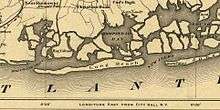Hog Island (New York)

Hog Island was the name of two islands near Long Island, New York until the 1890s. One, shown on the map at right, is the present day Barnum Island, part of Island Park, New York. The other was a mile-long (1600 m) barrier island that existed to the south of Rockaway Beach before being mostly destroyed by the 1893 New York hurricane and completely lost to erosion and storm damage by 1902.
History
Barnum Island
The Barnum Island/Island Park/Harbor Isle "Hog Island" was used by the Native Americans to raise pigs, once they had been introduced by Europeans and left to run feral. It later became a small farming area. In 1874 Sarah Ann Baldwin Barnum purchased the property (she is unrelated P.T. Barnum, despite local lore). A syndicate of businessmen were about to bid $70,000 for the property, but she persuaded the owner to it sell it to her for use as a working farm, to house and employ the poor. While she made the purchase with $13,360 of her own money, she immediately resold it to the Queens County government for the same price; at the time, Nassau was part of Queens.
In 1898, the county closed the almshouse, and sold the property to developers for $40,000.
In 1926, part of the island was incorporated as the Village of Island Park. The remainder is still unincorporated: the northeast portion of the island continues to be known as Barnum Island, while the western portion is called Harbor Island. All three are part of the Town of Hempstead.[1]
Lost island
Sea movement built up a large sandbar. Reports suggest that it began to emerge from the ocean during the Civil War period.[2] It was about 1,000 feet south of the Rockaway shore. Eventually, it grew to about a mile wide (parallel to the Rockaways) and several hundred feet deep. Shaped like a hogback, it came to be known as Hog Island, or sometimes as Far Rockaway Beach Island.
The island is believed to have hosted a number of seafront resorts.[2] Developers created resort businesses, including bathing facilities and restaurants. The island was a favorite getaway of Tammany Hall politicians, and many "backroom deals" were actually concluded in the open air here.[3]
On the night of August 23, 1893, the 1893 New York hurricane, a devastating Category 2 hurricane made landfall. By the following morning, August 24, Hog Island had mostly disappeared. News reports included a dramatic rescue from the island, among the other descriptions of the power of the storm. (Reports of 30 foot (9m) waves at Coney Island as far as 200 yards (180 m) inland; destruction of the elevated railroad there; the East River cresting the sea wall in the Astoria district; waist-high water in the streets of the City of Brooklyn.)[4]
After the 1893 storm, some redevelopment occurred on the now-reduced Hog Island. It is believed to have submerged entirely in 1902.[2]
In the mid-1990s, after the nor'easters of December 1992 and March 1993 heavily damaged the coast of Rockaway, the Army Corps of Engineers began rebuilding Rockaway Peninsula beaches. They used sands dredged close to shore.[5] Professor Nicholas Coch of Queens College, along with local undergraduate students, was observing the work and its results, replenishing of the beaches along Rockaway when they noticed peculiar items along the coast. The group uncovered hundreds of different artifacts including whiskey bottles, beer mugs, and even a hurricane lamp. The majority of the items were dated around the late 19th century. Coch believes they came from Hog Island, but admits they could have been the result of the 1893 storm's devastation in other nearby resort areas.
Curious about their findings, the Queens College group started to unravel the history of Hog Island. Their research also led to a reassessment of the frequency of major hurricanes in the New York City area (see Analysis, below).[3][6]
Analysis
The city of New York has averaged a major hurricane approximately every 70 to 80 years throughout its history. It was predicted in 2005 that if the city were to be directly hit by another hurricane of the intensity of the one in 1893, which destroyed Hog Island, the damage was likely to be enormous.[6] In 2012, the effects of Hurricane Sandy in New York were very destructive but was not a worst-case scenario, especially in terms of wind. A landfalling Category 3 or higher would prove to be far more destructive.
References
- ↑ Newsday
- 1 2 3 Onishi, Norimitsu (March 18, 1997). "Queens Spit Tried to Be a Resort but Sank in a Hurricane". New York Times. Retrieved 2010-02-25.
- 1 2 Onishi, Norimitsu (19 March 1997). "Queens Spit Tried to Be a Resort but Sank in a Hurricane". The New York Times. Retrieved 12 November 2012.
- ↑
- ↑ "New York City Hurricane". Mega Disasters. Season 1. Episode 3. History.
- 1 2 "The Big One". New York Press. July 27, 2005. Retrieved 2010-02-25.